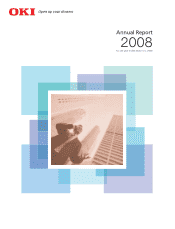Oki 2008 Annual Report Download - page 8
Download and view the complete annual report
Please find page 8 of the 2008 Oki annual report below. You can navigate through the pages in the report by either clicking on the pages listed below, or by using the keyword search tool below to find specific information within the annual report.
6Annual Report 2008
OKI Segments at a Glance
Year ended March 31, 2008
Note: Not included with the three principal segments reviewed below is OKI’s Other segment.
Info-Telecom Systems
Segment
(Comprising the Financial Business Group,
the Telecom Business Group and the
Information System Business Group)
Info-Telecom
Systems
Semi-
conductors
Printers
Semiconductors
Segment
Printers Segment
Compared with the previous fiscal year, the financial systems business recorded
a more than fourfold rise in ATM shipments to China. On the domestic front,
OKI also benefited from a recovery, mainly in replacement demand for ATMs,
as well as from increased sales to Japan Post Holdings Co., Ltd. As a result,
financial systems business sales grew year on year. Results in the information
systems business were boosted by system sales growth to the corporate
sector. Sales in the telecom system business showed a year-on-year decline,
however, impacted by ongoing investment cutbacks in fixed-line network
systems by various carriers as well as by OKI’s accelerated selection and focus
initiatives centering on the withdrawal from low-profit businesses. Contributions
from the full-scale introduction of the next-generation network (NGN)
business will materialize later than expected; the OKI Group now anticipates
that NGN business benefits will start to accrue from the second half of the
fiscal year ending March 31, 2009.
As a result of the foregoing factors, consolidated segment sales, excluding
intersegment sales, increased 1.8% year on year to ¥359.0 billion. Significantly
affected by the drop in telecom system business sales, the info-telecom
systems segment incurred an operating loss of ¥1.7 billion, a ¥0.2 billion
deterioration from the ¥1.5 billion loss in the previous fiscal year.
In the semiconductors segment, sales of logic large-scale integrations (LSIs)
declined due to a fall in demand caused by product lifecycle factors for LSIs
used in small- and mid-sized panels, as well as to stagnant demand for
base-band LSIs for PHS applications in China. In addition, OKI took steps to
rationalize product development in low-profit system LSIs, resulting in lower
sales in the product category. On a positive note, P2ROMs for the amusement
market and foundry businesses that employ such unique technology as
high-voltage processes performed well.
As a result, consolidated segment sales, excluding intersegment sales,
decreased 5.0% year on year to ¥138.2 billion. Operating income, however,
showed an improvement of ¥3.1 billion from the ¥0.7 billion recorded in the
previous fiscal year to ¥3.8 billion, owing to OKI’s initiatives to streamline
low-profit products and reduce fixed and variable operating costs.
In the printers segment, OKI accelerated the rationalization of its product
portfolio, increasing its focus on mid- and high-range, business-use color
non-impact printers (NIPs), which resulted in a decline in low-range model
shipments. In contrast, sales of consumables increased compared with the
previous fiscal year. Due to these factors, earnings in the printers segment
showed substantial growth. Fluctuations in foreign exchange rates, particularly
the yen’s depreciation against the euro, also contributed to higher profits.
Accounting for these factors and excluding intersegment sales, consolidated
printers segment sales dipped 0.7% year on year to ¥185.8 billion, while
operating income jumped ¥6.9 billion from the ¥1.7 billion posted in the
previous fiscal year to ¥8.6 billion.
Percentage of
Net Sales by Business
Segment (%)
49.9%
Percentage of
Net Sales by Business
Segment (%)
19.2%
Percentage of
Net Sales by Business
Segment (%)
25.8%





















